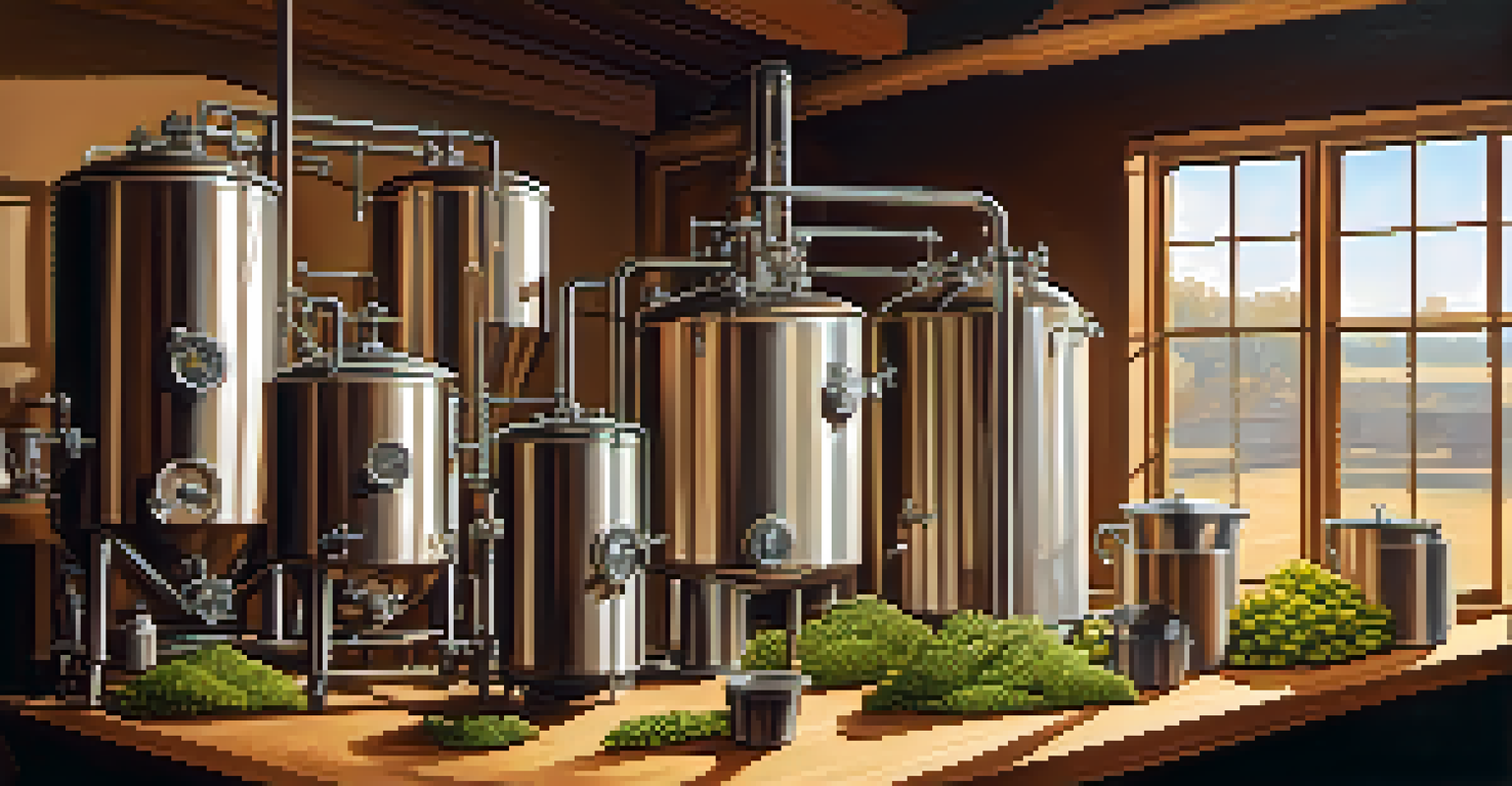Understanding the Brewing Process: Fermentation Explained

What is Fermentation in Brewing?
Fermentation is a crucial step in the brewing process, turning sugars into alcohol and carbon dioxide. At its core, fermentation involves yeast, a tiny microorganism that transforms the sugary wort into beer. This transformation not only produces alcohol but also contributes to the flavors and aromas that make each beer unique.
Without yeast, there is no beer.
In brewing, the wort is created by steeping grains in hot water, extracting their sugars. Once this sugary liquid is cooled, yeast is added, and the fermentation begins. This natural process can take anywhere from a few days to several weeks, depending on the type of beer being produced.
Understanding fermentation is vital for brewers, as it can greatly influence the final product. From the choice of yeast to the fermentation temperature, each decision impacts the flavor profile, alcohol content, and overall character of the beer.
The Role of Yeast in Fermentation
Yeast is often referred to as the magic ingredient in fermentation, and for a good reason. This single-celled organism not only ferments sugars but also produces various compounds that enhance the beer's complexity. Different yeast strains can impart fruity, spicy, or even floral notes to the finished brew.

When yeast consumes the sugars in wort, it produces ethanol (alcohol) and carbon dioxide as byproducts. The balance of these compounds is what makes each beer distinct. For instance, ales typically use top-fermenting yeast, which works at warmer temperatures, while lagers use bottom-fermenting yeast at cooler temperatures.
Fermentation Turns Sugar to Alcohol
Fermentation is the process where yeast transforms sugars in the wort into alcohol and carbon dioxide, shaping the unique flavors of each beer.
Choosing the right yeast strain is crucial for brewers aiming for a specific flavor profile. This decision can make the difference between a crisp lager and a bold stout, demonstrating the profound impact yeast has on the fermentation process.
The Fermentation Timeline Explained
Fermentation is not an instantaneous process; it unfolds over several stages. Initially, there's a vigorous fermentation phase where yeast activity peaks, often causing bubbling and foaming. This primary fermentation typically lasts about one to two weeks, during which the majority of alcohol is produced.
Brewing is a journey, not a destination.
After the primary fermentation, brewers often move the beer to a secondary fermenter, allowing additional flavors to develop and settling out any unwanted particles. This secondary phase can last from a week to several months, depending on the desired clarity and taste.
Understanding this timeline is essential for brewers to manage their expectations and quality. Each phase plays a critical role in shaping the beer, making it a careful balancing act between time and flavor development.
Factors Influencing Fermentation
Several factors can significantly impact the fermentation process, with temperature being one of the most critical. Yeast thrives within specific temperature ranges, and deviations can lead to stalled fermentation or off-flavors. For example, warmer temperatures can result in fruity esters, while cooler temperatures promote a cleaner taste.
Oxygen levels also play a vital role during fermentation. While yeast needs oxygen at the beginning to multiply, too much oxygen later in the process can lead to spoilage. This delicate balance is something brewers must carefully monitor to ensure a successful fermentation.
Yeast Variety Impacts Beer Flavor
Different strains of yeast can impart unique flavors and aromas to beer, making the choice of yeast crucial for achieving a specific profile.
Finally, the type of ingredients used can also affect fermentation. Different grains, adjuncts, and even water chemistry can introduce various flavors, making it important for brewers to understand how these elements interact during the process.
The Importance of Hygiene in Fermentation
Maintaining hygiene during fermentation is vital to achieving high-quality beer. Contaminants, such as wild yeast or bacteria, can spoil the beer and produce undesirable flavors. Cleanliness in the brewing environment, as well as proper sanitation of equipment, is essential to prevent such issues.
Brewers often use chemical sanitizers and heat to ensure all equipment is free from contaminants before fermentation begins. This attention to detail helps protect the integrity of the beer during the fermentation process.
By prioritizing hygiene, brewers can focus on the flavors and characteristics they want to achieve without worrying about unwanted surprises. It's a simple yet effective way to safeguard the quality of the final product.
Troubleshooting Common Fermentation Issues
Fermentation doesn’t always go smoothly, and brewers may encounter various issues along the way. Common problems include stuck fermentation, where yeast stops working prematurely, often due to inadequate temperature or nutrient levels. Recognizing these signs early can help brewers take corrective actions.
Another issue might be off-flavors, which can arise from various factors, such as improper sanitation or temperature fluctuations. For example, if fermentation gets too warm, it may produce unwanted esters or fusel alcohols that compromise the beer's taste.
Hygiene Is Key to Quality Beer
Maintaining strict hygiene during fermentation prevents contamination, ensuring that the desired flavors are preserved without unwanted surprises.
Troubleshooting these issues is part of the brewing journey. By understanding potential pitfalls and how to address them, brewers can refine their process and create better beer with each batch.
The Final Steps: Bottling and Carbonation
Once fermentation is complete, the next steps are bottling and carbonation. This stage involves transferring the beer into bottles or kegs and adding a priming sugar, which encourages a secondary fermentation in the container. This process is crucial for developing the carbonation that gives beer its refreshing fizz.
During this final fermentation phase, the yeast consumes the added sugar and produces carbon dioxide, resulting in the beer's signature bubbles. This step is often overlooked, but it plays a significant role in the overall drinking experience.

Finally, after a brief conditioning period, the beer is ready to be enjoyed. This culmination of the brewing and fermentation process showcases the hard work and care that went into creating the final product, highlighting the importance of each step along the way.